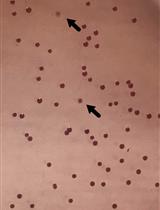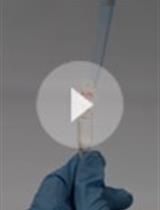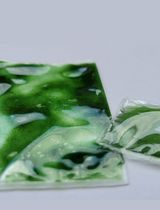- EN - English
- CN - 中文
Induction, Isolation and Counting of Akinetes in Aphanizomenon ovalisporum
束丝藻属中原垣孢子的诱导、分离和计数
发布: 2016年05月20日第6卷第10期 DOI: 10.21769/BioProtoc.1808 浏览次数: 8449
评审: Maria SinetovaClaudia CatalanottiAnonymous reviewer(s)
Abstract
Akinetes are spore-like resting (dormant) cells formed by strains of filamentous cyanobacteria for surviving long periods of unfavorable conditions. During deprivation for potassium, vegetative photosynthetic cells along the filaments of the cyanobacterium Aphanizomenon ovalisporum (A. ovalisporum) (strain ILC-164) differentiate into akinetes. Akinetes are larger than vegetative cell, have a thick wall, accumulate storage compounds (cyanophycine, glycogen, lipids) and excess of DNA (Sukenik et al., 2015; Sukenik et al., 2007; Maldener et al., 2014). Differences in structure and composition between akinetes and vegetative cells allow separation and isolation of akinetes. Akinetes isolated by the described protocol can be utilized for protein analysis, measurements of metabolic activities, fluorescence in situ hybridization (FISH) studies and more.
Materials and Reagents
- Erlenmeyer flasks of appropriate volume
- 50 ml tubes (SARSTEDT AG & Co, catalog number: 62.547.004 )
- 250 ml centrifuge bottle (TermoFisher SCIENTIFIC, catalog number: 3141-0250 )
- Aphanizomenon ovalisporum, strain ILC-164 [isolated from Lake Kinneret, Israel (Banker et al., 1997)]
- BG11 growth medium (Stanier et al., 1971)
- BG/-K akinete induction medium
Note: BG11 medium in which the K2HPO4 component was substituted with Na2HPO4. - Sodium chloride (NaCl) (Sigma-Aldrich, catalog number: S9888 )
- Ethylenediaminetetraacetic acid disodium salt dehydrate (Na-EDTA) (Sigma-Aldrich, catalog number: E5134 )
- Magnesium chloride (MgCl2) (Sigma-Aldrich, catalog number: M8266 )
- Lysozyme from chicken egg white (Sigma-Aldrich, catalog number: L6876 )
Note: It is also named as “Mucopeptide N-acetylmuramoylhydrolase” or “muramidase”. - Lugol’s solution (Sigma-Aldrich, catalog number: L6146 )
- SYTOX (Invitrogen, catalog number: S7020 )
Note: Currently, it is “SYTOX® Green Nucleic Acid Stain-5 mM Solution in DMSO” (Thermo Fisher Scientific, Molecular ProbesTM, catalog number: S7020). - Coomassie brilliant blue R-250 staining solution (BIO RAD catalog number: 1610436 ).
- Molecular weight markers [All blue pre-stained protein standards (M. W. 10-250 kD)] (Bio-Rad Laboratories, catalog number: 1610373 )
- Tris (Sigma-Aldrich, catalog number: 252859 )
Note: It is also named as “Tris (hydroxymethyl) aminomethane” on Sigma-Aldrich website. - Tris buffer(see Recipes)
- Tris-EDTA-Mg buffer (see Recipes)
- Tris-Mg buffer (see Recipes)
- TE buffer (see Recipes)
- 0.5 M EDTA stock solution (see Recipes)
- 1 M MgCl2 stock solute (see Recipes)
- 1 M NaCl (see Recipes)
Equipment
- Spectrophotometer (such as Uvikon XS SECOMAM)
- Sorvall centrifuge RC 6 Plus and appropriate rotor for the centrifuge tubes or bottles
- Vortex
- Sonicator [e.g., Sonifier 450 (Branson Ultrasonics)]
- Orbital shaker (e.g., MaxQTM 2000 and 3000 benchtop orbital shaker, TermoFisher SCIENTIFIC, model number: SHKA2000 )
- Incubator (regulated temperature and light)
- Bright field/fluorescent inverted microscope (e.g., Zeiss Axioobserver Z1)
Note: Use the following filter sets: for chlorophyll (EX-425-443 nm; BS-452 nm; EM-496 nm LP), for Phycobilins (EX-510-550 nm; BS-565 nm; EM-582 nm LP) and for SYTOX (EX-445-495 nm; BS-500 nm; EM-505-555 nm). - Utermohl sedimentation chamber (Aquatic Research Instruments, http://www.aquaticresearch.com/sedimentation_chamber.htm)
- Thermostatic water bath
Procedure
文章信息
版权信息
© 2016 The Authors; exclusive licensee Bio-protocol LLC.
如何引用
Sukenik, A., Kaplan-Levi, R. N., Viner-Mozzini, Y., Lupu, A. and Sela, D. (2016). Induction, Isolation and Counting of Akinetes in Aphanizomenon ovalisporum. Bio-protocol 6(10): e1808. DOI: 10.21769/BioProtoc.1808.
分类
微生物学 > 微生物细胞生物学 > 细胞分离和培养
微生物学 > 微生物细胞生物学 > 细胞活力
您对这篇实验方法有问题吗?
在此处发布您的问题,我们将邀请本文作者来回答。同时,我们会将您的问题发布到Bio-protocol Exchange,以便寻求社区成员的帮助。
Share
Bluesky
X
Copy link















